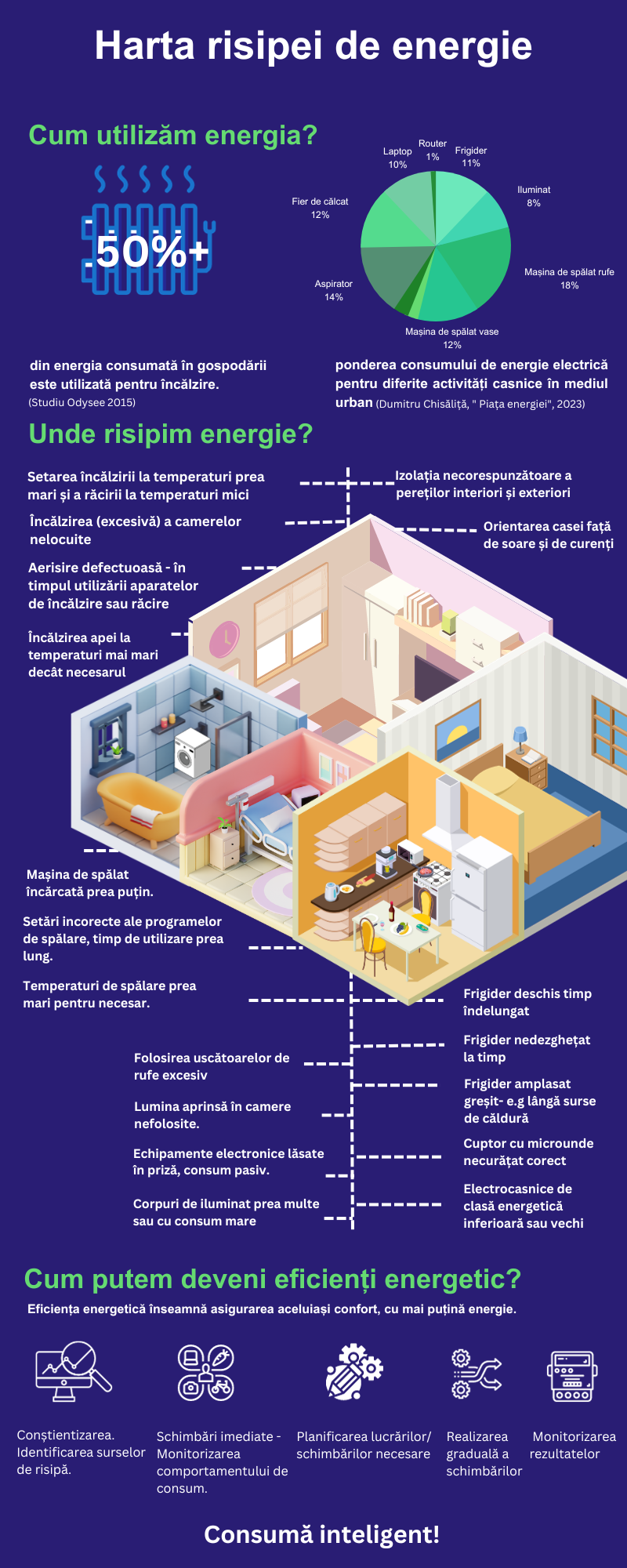
Romania is sitting on a huge “fuel reserve” that they ignore or ridicule. In energy circles, this potential is called “primary fuel” because it is available and ultimately free. Its name is energy efficiency. Unfortunately, with a history of rationalization and unpleasant memories of the communist era, many of us prefer to be angry or sarcastic about it. After all, what else do we want, just that we consume less than the European average?
93% of buildings in Romania were built before 1990[1]without updated efficiency standards, not renovated for decades, so energy losses are almost double what would be necessary to ensure the thermal comfort of those using the buildings.
We have over 242,000 public buildings with consumption above 200-250 kWh/m2 [2]compared to the average recommended at the European level of 140 kWh/m2. We have more than 5 million residential buildings, of which less than 10% of the total area has been renovated today.
Summary calculation[3] shows that if we were to achieve the recommended consumption per square meter, we would achieve annual savings of over 6 billion lei in public buildings alone. With this money, we could build 10 secondary schools or 2 district hospitals[4], without taking into account the positive impact on security of supply, the environment, etc. For residential buildings, the benefits of energy efficiency go directly into the pockets of tenants, who can save up to 44% on consumption[5].

The reality is that if we participate in the exploitation of this “fuel storage” in public buildings, we could have money to build schools or hospitals or new projects for the comfort of citizens. That is, instead of spending money on heating or cooling, which we literally throw out the window, we would have some savings that could go to schools, hospitals, decent halls, infrastructure, whatever.
Good, but repairs are expensive and time-consuming. Designers and construction companies are also needed, which can cover the amount of work, materials and money.
A review of public information shows us that Bucharest city halls, for example, carry out an average thermal rehabilitation of almost 200 blocks per year, while in each sector 1,200-1,400 blocks are still waiting to be completed out of about 16,000. From the experience of housing works, at current prices the cost of about 1 million euros for the 8th floor block.[6], the actual work takes 4-5 months, and the implementation of the project with obtaining conclusions and approvals takes 2 years. All blocks require at least 80 years and 16 billion euros, just for Bucharest. This is a final calculation, as it changes from situation to situation, but it is an assessment that shows us how important it is to plan an approach to energy efficiency not for today, for tomorrow, but for the long term, and how relevant it becomes to be able to guide our behavior and make immediate changes, those that do not cost, but on the contrary will save money, when performing large works.
In common areas, public buildings, schools, hospitals, efficiency measures can be applied, starting with proper cleaning and maintenance of heating and cooling equipment, ending with ventilation and lighting of premises. Motion sensors, proper use of electronic equipment, checking window insulation, less frequent use of elevators are just some of the possibilities[7].
On the other hand, for the planning required for larger energy efficiency investment works, it is important that each of us is aware and engaged in dialogue with the local authority, public buildings or community, tenant association. , for public places. Here we are talking not only about energy efficiency, but about the decision to take an active part in decision-making for our community.
We are sitting on a supply of valuable fuel that can directly benefit us in development through the intelligent use of energy. Even if Romania consumes less than the average European level, it does not mean that we can afford to waste energy when we can use the resources for development projects.
This material is part of the project “Energy Efficiency in Smart Homes, Smart Buildings and Smart Grids” initiated by the Association of Energy Utilities (ACUE) and funded by grants through the Norwegian Financial Mechanism 2014-2021. , as part of the “Energy Program from Romania”.
***
[1] https://www.mdlpa.ro/uploads/articole/attachments/60096d5354394459864321.pdf
[2] https://energy.ec.europa.eu/system/files/2014-11/2014_article4_ro_romania_0.pdf
[3]The surface of public buildings – 62 million m2/approximate average consumption (varies from 150 to 400 kWh/m2) 225 kW/h/m2/ energy price 1.3 lei (maximum limited price) Total cost 18.135 billion lei. For the recommended consumption – 62 million m2 – consumption 140 kWh/m2 – energy price 1.3 leads to total costs of 11.284 billion lei / difference – 6.851 billion lei – approximately 1.2 billion euros
[4] The calculation was made on the basis of announced public projects
[5] Study European Institute for Building Performance.
[6] In sector 6, 37 units were energy renovated in 2021 with 180 million lei – an average price of 4.5 million (similar to sectors 3 and 4). Rounding up to 1 million euros/block of 8 floors, to simplify the approximate calculation. Data source – https://observatornews.ro/economic/la-cat-ajung-preturile-pentru-anveloparea-bloculurilor-din-bucuresti-in-functie-de-zona-cel-mai-scump-este-in-sectorul -6-488155.html
[7] A useful guide for those who manage buildings https://eficient-energetic.ro/cladiri-inteligente
Article supported by ACUE
Source: Hot News
Ashley Bailey is a talented author and journalist known for her writing on trending topics. Currently working at 247 news reel, she brings readers fresh perspectives on current issues. With her well-researched and thought-provoking articles, she captures the zeitgeist and stays ahead of the latest trends. Ashley’s writing is a must-read for anyone interested in staying up-to-date with the latest developments.